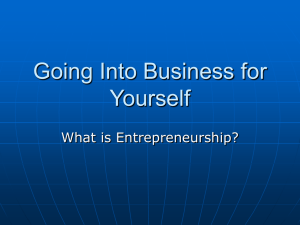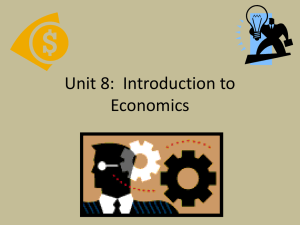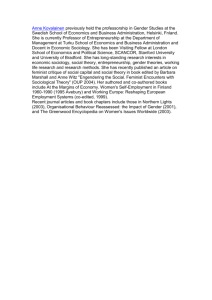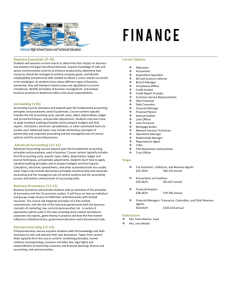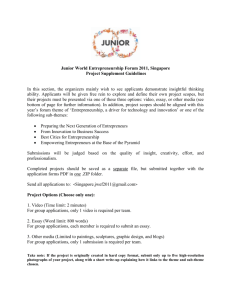Document 11757748
advertisement
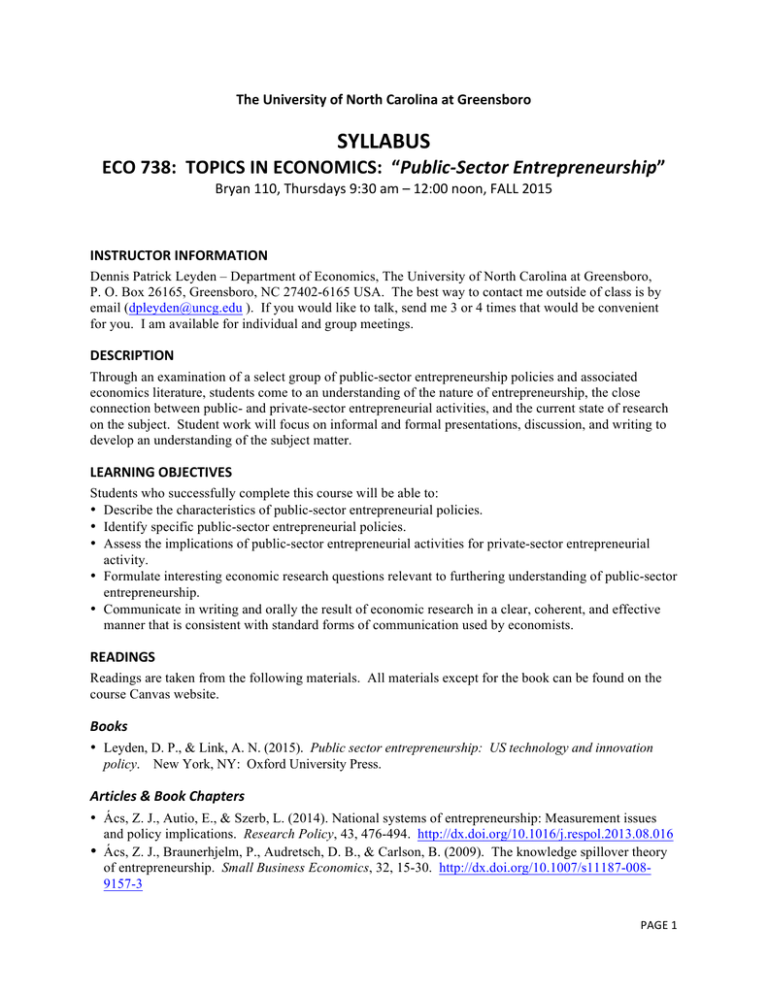
The University of North Carolina at Greensboro SYLLABUS ECO 738: TOPICS IN ECONOMICS: “Public-­‐Sector Entrepreneurship” Bryan 110, Thursdays 9:30 am – 12:00 noon, FALL 2015 INSTRUCTOR INFORMATION Dennis Patrick Leyden – Department of Economics, The University of North Carolina at Greensboro, P. O. Box 26165, Greensboro, NC 27402-6165 USA. The best way to contact me outside of class is by email (dpleyden@uncg.edu ). If you would like to talk, send me 3 or 4 times that would be convenient for you. I am available for individual and group meetings. DESCRIPTION Through an examination of a select group of public-sector entrepreneurship policies and associated economics literature, students come to an understanding of the nature of entrepreneurship, the close connection between public- and private-sector entrepreneurial activities, and the current state of research on the subject. Student work will focus on informal and formal presentations, discussion, and writing to develop an understanding of the subject matter. LEARNING OBJECTIVES Students who successfully complete this course will be able to: • Describe the characteristics of public-sector entrepreneurial policies. • Identify specific public-sector entrepreneurial policies. • Assess the implications of public-sector entrepreneurial activities for private-sector entrepreneurial activity. • Formulate interesting economic research questions relevant to furthering understanding of public-sector entrepreneurship. • Communicate in writing and orally the result of economic research in a clear, coherent, and effective manner that is consistent with standard forms of communication used by economists. READINGS Readings are taken from the following materials. All materials except for the book can be found on the course Canvas website. Books • Leyden, D. P., & Link, A. N. (2015). Public sector entrepreneurship: US technology and innovation policy. New York, NY: Oxford University Press. Articles & Book Chapters • Ács, Z. J., Autio, E., & Szerb, L. (2014). National systems of entrepreneurship: Measurement issues and policy implications. Research Policy, 43, 476-494. http://dx.doi.org/10.1016/j.respol.2013.08.016 • Ács, Z. J., Braunerhjelm, P., Audretsch, D. B., & Carlson, B. (2009). The knowledge spillover theory of entrepreneurship. Small Business Economics, 32, 15-30. http://dx.doi.org/10.1007/s11187-0089157-3 PAGE 1 SYLLABUS for ECO 738: TOPICS IN ECONOMICS FALL 2015 • Arrow, Kenneth J. (1962). Economic welfare and the allocation of resources for invention. In R.R. Nelson (Ed.), The rate and direction of inventive activity: Economic and social factors (pp. 609626). Princeton: Princeton University Press. Retrieved from http://www.nber.org/chapters/c2144 • Atkinson, R. D. (2007). Expanding the R&E tax credit to drive innovation, competitiveness and prosperity. Journal of Technology Transfer, 32, 617-628. http://dx.doi.org/10.1007/s10961-0079046-y • Brod, A. C., & Link, A. N. (2001). Trends in cooperative research activity. In M. Feldman & A. Link (Eds.), Innovation policy in the knowledge-based economy (pp. 105-120). Norwell, MA: Kluwer. • Calcagnini, G., Giombini, G., Liberati, P., & Travaglini, G. (forthcoming). A matching model of university-industry collaboration. Small Business Economics. • Coase, R. H. (1937). The nature of the firm. Economica, 4, 386-405. http://dx.doi.org/10.1111/j.14680335.1937.tb00002.xCoase, • Coase, R. H. (1960). The problem of social cost. Journal of Law and Economics, 3, 1-44. http://dx.doi.org/10.1002/sres.3850090105 • Farag, H., Mallin, C., & Ow-Yong, K. (2014). Governance, ownership structure, and performance of entrepreneurial IPOs in AIM companies. Corporate Governance: An International Review, 22, 100115. http://dx.doi.org/10.1111/corg.12049 • Granovetter, M. S. (1973). The strength of weak ties. American Journal of Sociology, 78, 1360–1380. http://dx.doi.org/10.1086/225469 • Hall, B. H., Link, A. N., & Scott, J. T. (2001). Barriers inhibiting industry from partnering with universities: Evidence from the advanced technology program. Journal of Technology Transfer, 26, 87-98. http://dx.doi.org/10.1023/a:1007888312792 • Knight, F. H. (1921). The meaning of risk and uncertainty. In Risk, uncertainty, and profit (pp. 99117). Boston MA: Houghton Mifflin. Retrieved from http://oll.libertyfund.org/title/306 . • Leyden, D. P. (2015, June 14). Public-sector entrepreneurship and the creation of sustainable innovative economy. Small Business Economics (Submitted for review). • Leyden, D. P., & Link, A. N. (2014). Toward a theory of the entrepreneurial process. Small Business Economics. http://dx.doi.org/10.1007/s11187-014-9606-0 • Link, A. N., & Scott, J. T. (2010). Government as entrepreneur: Evaluating the commercialization success of SBIR projects. Research Policy, 39, 589-601. http://dx.doi.org/10.1016/j.res • Link, A. N., Siegel, D. S., & Van Fleet, D. D. (2011). Public science and public innovation: Assessing the relationship between patenting at US national laboratories and the Bayh-Dole Act. Research Policy, 40, 1094-1099. http://dx.doi.org/10.1016/j.respol.2011.05.011 • Samuelson, P. A. (1954). The pure theory of public expenditure. Review of Economics and Statistics, 36, 387–389. http://dx.doi.org/10.2307/1925895 • Samuelson, P. A. (1955). Diagrammatic exposition of a theory of public expenditure. Review of Economics and Statistics, 37, 350–356. http://dx.doi.org/10.2307/1925849 • Schacht, Wendy H. (2009). The Bayh-Dole Act: Selected issues in patent policy and the commercialization of technology. Washington, DC: Congressional Research Service. Retrieved from http://assets.opencrs.com/rpts/RL32076_20090203.pdf • Schumpeter, J. A. (2003; original 1943). The process of creative destruction. In Capitalism, socialism and democracy (pp. 81-86). London, UK: Routledge. • Solow, R. M. (1956). A contribution to the theory of economic growth. Quarterly Journal of Economics, 70, 65-94. http://dx.doi.org/10.2307/1884513 • Tassey, Gregory (2007). Tax incentives for innovation: Time to restructure the R&E tax credit. Journal of Technology Transfer, 32, 605-615. http://dx.doi.org/10.1007/s10961-007-9045-z PAGE 2 SYLLABUS for ECO 738: TOPICS IN ECONOMICS FALL 2015 CONDUCT OF THE COURSE This course consists of 14 weekly seminars in which students work together to develop their understanding of public-sector entrepreneurship. Class activities include a mix of lectures, student-led and instructor-led discussions, and formal student presentations. Students are expected to read all assigned material ahead of time and come to class ready to actively participate in class discussions. Students write a term paper that identifies an example of indirect public-sector entrepreneurship and analyze that example in terms of intent, structure, and effect. The course then concludes with an essay assignment in which students review their understanding of public-sector entrepreneurship, review the current state of the literature, and suggest a fruitful avenue for future research. EVALUATION & GRADING The course grade will be based 6 assignment categories (listed below). Grading for individual assignments will initially be done using rubrics. At the end of the semester, aggregate points for each assignment category will be converted to a 100 point scale (with the standard 10-point letter-grade ranges), and a weighted average of these converted scores will be calculated (rounded to two decimal places) using the weights listed below. The top third of each 10-point letter-grade range will be noted with a plus and the bottom third of each 10-point letter-grade range will be noted with a minus. • • • • • • Student-Led Discussions ................................................................................ 15% Class Participation ............................................................................................ 5% Term Paper (1st Complete Draft) .................................................................... 15% Term Paper Presentation ................................................................................ 30% Term Paper (Final Complete Draft) ............................................................... 30% Essay Assignment ........................................................................................... 5% Late written assignments will receive a deduction of 10% of the maximum score for every calendar day that they are late (measured in 24 hour increments from the due date and time); late term paper presentations will receive a deduction of 20% of the maximum score for every calendar day that they are late. Failure to lead discussions on the assigned date will result in a zero score. ASSIGNMENTS Student-­‐Led Discussions Students will lead approximately 5-6 discussions that focus on the content and significance of various assigned readings. Such discussions should focus on introducing the material (subject, importance, main point), analyzing and critiquing the theoretical and empirical analyses in the reading(s), and concluding the discussion with a brief summary and examination of implications/consequences of the work. Students should employ slides to facilitate discussion. Class Participation Students are required to activity participate in all discussions through such actions as asking questions, answering questions, offering examples and explanations, etc. Participation should be motivated by a desire to better understand the material and to help others in the class do the same. Term Paper Students are required to research, write, present, and revise a term paper that identifies an example of indirect public-sector entrepreneurship and analyzes that example in terms of intent, structure, and effect. PAGE 3 SYLLABUS for ECO 738: TOPICS IN ECONOMICS FALL 2015 The paper should be 2500-3750 words (exclusive of the paper’s cover, references, diagrams, etc.). This length is approximately a 10-15 page double-spaced paper. Further requirements will be provided in class. The paper should have a formal essay structure with an introduction (in which the subject, importance, and main point of the essay are described), a body (in which conceptual and/empirical evidence is used to support the assertions that are used to prove the main point), and a conclusion (in which the main point is restated and implications/consequences of the main point’s truth are briefly explored). APA style should be used when formatting citations, references, and endnotes. The first draft of the paper should be submitted electronically as an MS Word file by the date and time noted below in the course calendar. A schedule of who is to present on which day will be arranged ahead of time. Presentations based on the paper should be 15 minutes long. Finally, a revised, final draft of the paper based on feedback from the class and the instructor should be submitted electronically as an MS Word file on the date and time noted below in the course calendar. Essay Assignment In an essay of approximately 1000 words, students define public-sector entrepreneurship, review the current state of the literature, suggest one fruitful avenue for future research, and justify why that avenue would be of value. The essay should have a formal essay structure with an introduction (in which the subject, importance, and main point of the essay are described), a body (in which conceptual and/empirical evidence is used to support the assertions that are used to prove the main point), and a conclusion (in which the main point is restated and implications/consequences of the main point’s truth are briefly explored). Further requirements will be provided in class. The essay assignment should be submitted electronically as an MS Word file on the date and time noted below in the course calendar. TOPICAL OUTLINE & CALENDAR The calendar below provides an outline of course activities along with the associated readings and assignment due dates. Classroom Activity Readings & Assignments (bold = student presentation) 20 AUG Introduction 27 AUG Background Literature (part 1) Arrow (1962) Coase (1937) Coase (1960) 3 SEP Background Literature (part 2) Granovetter (1973) Knight (1921) & Schumpeter (2003) Samuelson (1954, 1955) 10 SEP Developing the Notion of Private-­‐Sector Entrepreneurship Leyden & Link (2015) – Chapter 2 Leyden & Link (2014) 17 SEP Developing the Notion of Public-­‐Sector Entrepreneurship Leyden & Link (2015) – Chapters 1, 3 PAGE 4 SYLLABUS for ECO 738: TOPICS IN ECONOMICS FALL 2015 24 SEP Impetus for Public-­‐Sector Entrepreneurship Solow (1956) Leyden & Link (2015) – Chapters 4, 12 1 OCT Policy Analysis Literature • Bayh-­‐Dole Act of 1980 • Stevenson-­‐Wydler Act of 1980 Schacht (2009) Link, Siegel, & Van Fleet (2011) Leyden & Link (2015) – Chapters 5, 6 8 OCT 15 OCT Policy Analysis Literature • R&E Tax Credit of 1981 • Small Business Innovation Development Act of 1982 Policy Analysis Literature • National Cooperative Research Act of 1984 • Omnibus Trade & Competitiveness Act of 1988 Atkinson (2007) & Tassey (2007) Link & Scott (2010) Leyden & Link (2015) – Chapters 7, 8 Brod & Link (2001) Hall, Link, & Scott (2001) Leyden & Link (2015) – Chapters 9, 10 22 OCT Taking a Broader Perspective (part 1) Leyden (2015, June 14) Ács, Autio, & Szerb (2014) 29 OCT Taking a Broader Perspective (part 2) Ács, Braunerhjelm, Audretsch, & Carlson (2009) Farag, Mallin, & Ow-­‐Yong (2014) 5 NOV Taking a Broader Perspective (part 3) Calcagnini, Giombini, Liberati, & Travaglini (2015, June 1) 8 NOV NO CLASS Term Paper (Complete First Draft) due by 12:00 midnight. It should be submitted electronically. 12 NOV Paper Presentations (part 1) 19 NOV Paper Presentations (part 2) 4 DEC Complete Paper (Final Draft) due by 5:00 pm EST. It should be submitted by electronically. 8 DEC Essay Assignment due by 5:00 pm EST. It should be submitted electronically. PAGE 5


